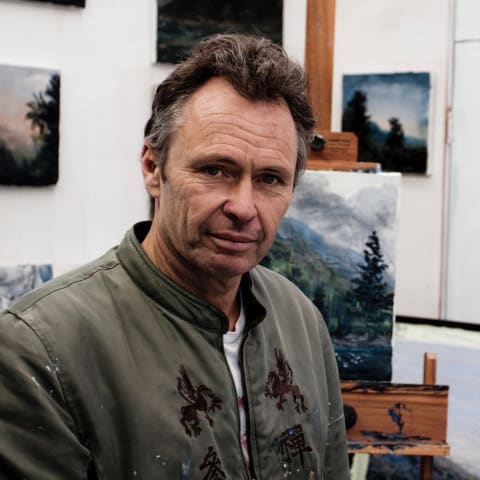David Roach, co-curator of the Clifton Contemporary Art Fair, talked to one of the high-profile participating artists.
Paul Ryan’s striking, often provocative paintings are sort by collectors both in Australia and internationally. Many feature the Northern Illawarra coast and escarpment as seen from the ocean. A Thirroul local, Paul has been surfing as long as he has been painting.
When did you start surfing?
I started surfing about the age of 15. I was living near Wollongong University at the time.
I would catch the train up every weekend with a surfboard. It was actually surfing that really introduced me to the wonders of the Northern Illawarra landscape. I’d be getting off the train just as the sun was rising. And there would be the escarpment with the sun hitting it. You’d hear the sound of the waves. I just remember that it was magical. And I fell in love with Thirroul and everything north of Thirroul, at the age of 15.
And that love affair continues to today.
After you left high school, you went to TAFE. You met the sculptor Ian Gentle at about this time.
Yes. At that time Ian Gentle was living in what is now the Clifton School of Arts. Downstairs was his really grubby living quarters. Upstairs was his studio where he made his work which he called his “critters”. He would go out in the bush and come back with all sorts of beautiful sticks he’d found. And he’d somehow weld them together using gum. That studio was literally wall to floor sticks in one corner, just piled up in a giant heap. And there was Ian with his big beard, smoking cigarettes, drinking a beer and making these critters. At the age of 16, that was my first insight into what an artist could be. I think Ian is one of the great Australian artists. He was such a generous man and he loved his students.
What happened after TAFE?
Four years straight of surfing on the dole! We were the Bob Hawke surf team! (Laughs.)
How does your experience in the ocean influence your work?
I do lots of paintings of the Northern Illawarra. It’s almost like a stage set. Years spent sitting out there on a surfboard, all those wasted years on the dole, I’ve always been looking and absorbing and seeing the escarpment couched in all its many moods, always different sorts of weathers. The perspective is from the water looking back to the land, which in turn feeds into my colonial work, which has a lot to do with the first view of this landscape by Cook as he sailed up the coast in the Endeavour. His view would have been of the waves and then the escarpment and the sky. And a few wisps of smoke here and there coming out, which would have been the only sign that they could tell that there were inhabitants there somewhere. As a visual artist, you tend to think about the people who lived here before we came. What were their stories? Who were they and how did they survive?
Tell me about the work that you’re putting into the Clifton Contemporary Art Fair.
It’s part of a series I’ve been working on this year on sailing ships. I’ve been thinking a lot about the stories I’ve heard of the Indigenous Australians. The first thing they saw of the Europeans were these sails on the horizon. You could just imagine this mysterious white. The pure definition of a UFO. Unidentified floating object! In some of the paintings the ship is reflected in the ocean. Some of the ships are being wrecked on the coast. I know indigenous people had words for those spaceships they saw. But I can’t use those words. I’m fascinated with the idea that they were just living their life and then one day, these forms came past, these white forms and they must have thought, “The ancestors are returning!” Their words meant something like “white ghosts and death”. They couldn’t have been more spot-on because that’s what it brought upon them, wasn’t it?
Paul, I’ve always considered you to be a bit of a provocateur. Is that the role of the artist for you? To push back against the status quo, to challenge how our community operates?
Some artists are provocateurs and I think that there’s an important role to be played there. I often have my art dealers begging me to tone things down a bit and make things less provocative. But I’m always looking for something new, some new way to make a mark, to make an image or a new idea to come up with. That’s what has always driven me. I’m lucky enough that the collectors and buyers follow me on that journey.
Has this part of the world changed significantly since you’ve been living here?
I’ve lived around the area for about 40 years, and I’ve seen major demographic change. A lot of the people I grew up with are either dead or in jail. Growing up here, there was this strange, sort of insular culture, xenophobic, suspicious of anyone different. There was heavy drinking and drug taking. A lot of that has gone and I think that’s bloody good. But let’s just hope that this place doesn’t get too gentrified to the point where all the artists and writers, filmmakers, musicians and poets end up leaving. That would be really sad. Because it is one of the things that makes this place so liveable and such a wonderful community for those of us who feel part of it.
For news on the Contemporary Art Fair: www.artsclifton.org








